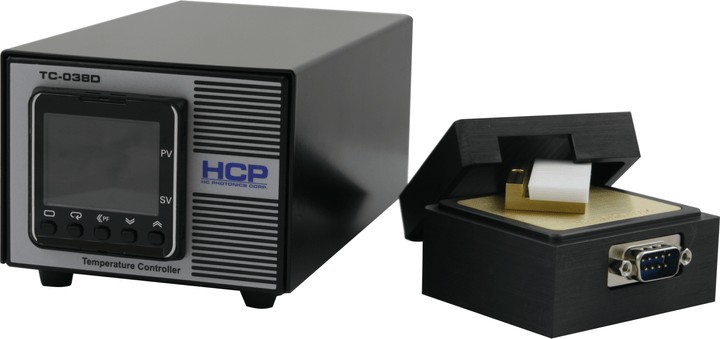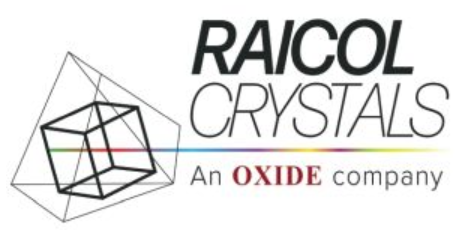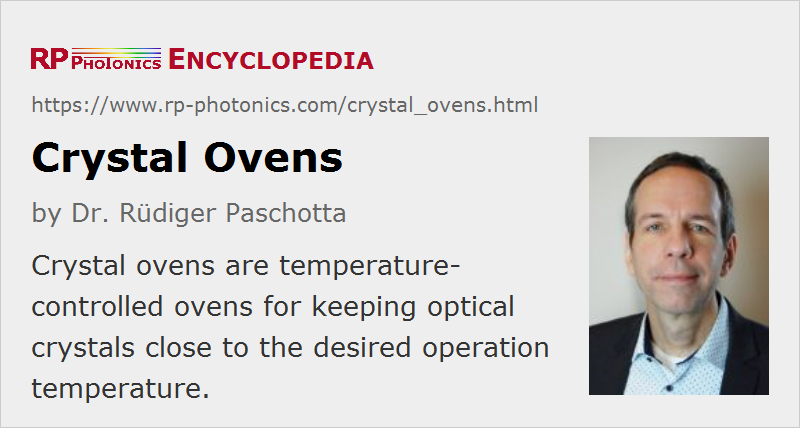Crystal Ovens
Definition: temperature-controlled ovens for keeping optical crystals at the desired operation temperature
German: Kristallöfen
Author: Dr. Rüdiger Paschotta
Cite the article using its DOI: https://doi.org/10.61835/it7
Get citation code: Endnote (RIS) BibTex plain textHTML
Optical crystals often need to be operated in an oven at an elevated and stable temperature. There are different reasons for that need:
- For nonlinear crystals, it is necessary to achieve noncritical phase matching for a nonlinear conversion process (e.g., frequency doubling or parametric amplification).
- Another reason can be to avoid problems with hygroscopic crystal materials such as BBO, as these tend to attract moisture from the air when being kept at room temperature over longer periods of time.
- Finally, there are some crystal materials such as LiNbO3 which exhibit disturbing photorefractive effects (particularly when operated with short-wavelength light), and these effects become weaker for operation at elevated temperatures.
Operation of a crystal at elevated temperatures is possible in a suitable crystal oven in combination with an electronic temperature controller (essentially a thermostat). The oven heaters are usually of simple resistive type, but Peltier elements are also used if the temperature differences are not too high (e.g., of the order of 30 Kelvin). Various technical challenges and possible solutions are discussed in the following. On that basis it is easy to recognize that a simple home-made oven with non-optimized design can not achieve the highest performance in all relevant respects. Also, it is clear that the oven design involves certain trade-offs, and these should ideally be done knowing the concrete requirements.
Temperature Range
Many crystal ovens can be operated up to about 200 °C, but some models can go much higher. The maximum temperature at which an oven can be operated is normally limited by the durability of materials, or possibly by the available heating power. Of course, it must be ensured that there is no substantial out-gasing from any materials of the oven, which might be deposited on the crystal's end faces.
High oven temperatures also lead to stronger convection currents in the ambient air. As the density and thus the refractive index of air is reduced for higher temperatures, convection of air can lead to disturbing beam distortions and deflections which fluctuate.
The minimum temperature often has to be somewhat above the ambient temperature, since otherwise the heat flow becomes very weak, and the settling time (see below) becomes too long.
Precision and Homogeneity of the Temperature
The phase-matching conditions for nonlinear processes in crystals are often highly temperature-sensitive; the phase-matching bandwidth in terms of temperature is sometimes well below 1 K, although in other cases it may be several Kelvin. This means that in some cases the temperature should be kept very precisely at the desired value.
In addition, one should also have quite low temperature variations along the whole beam path. A common problem is that the ends of the crystal are somewhat colder than the middle, e.g. because they are exposed to colder air (see below). This can lead to some reduction in power conversion efficiency or in the gain of an optical parametric amplifier. Figure 1 illustrates this effect. A reduced magnitude of temperature variations can tentatively be achieved with a longer oven design.

The solid curve applies when the crystal temperature is constant within the crystal. The dashed curve applies to a case with a parabolic temperature profile, where the ends have a 0.5 K lower temperature than the middle.
Particularly sensitive conditions arise for certain crystal materials and phase-matching configurations, and if a long nonlinear crystal is used. Note that for a long crystal the temperature deviations from the average must be smaller than for a short one, while it also becomes more difficult to obtain even the same maximum temperature deviations as for a short crystal. To achieve a certain temperature homogeneity also becomes more challenging for higher operation temperatures, as these imply higher thermal powers and thus higher thermal gradients within the oven.
Before deciding for an oven design, one should calculate how stringent the demands on temperature homogeneity are. An oven working well in a certain situation may not be sufficient in another one, as the requirements can differ very much.
Access for a Laser Beam; Open vs. Sealed Ovens
In contrast to crystal ovens for non-optical applications, such as those for quartz crystals used as frequency standards, ovens for optical crystals must allow access of some laser beam. Typically, a beam has to propagate through the crystal, i.e., it must enter the crystal on one side and exit on the other side. This necessity makes the oven design more difficult. There are in principle two different approaches:
- The oven may have free openings through which the optical beam can pass. This avoids any problems with optical windows (see below), but air can also freely move in and out. This leads to some cooling of the oven, and particularly of the crystal's end faces. It thus becomes more difficult to minimize temperature inhomogeneities.
- The movement of air at least inside the oven can be prevented by using a closed (sealed) design with optical windows. These, however, can have various detrimental side effects. Even if they are anti-reflection coated, they create at least some weak reflections, which may disturb the source of the beam if they directly go back to the source. A slight deviation from normal incidence can cure this problem, but some power losses remain. (This is most critical for crystals in enhancement cavities.) For operation in a wide wavelength region, low-loss transmission may be difficult to achieve. Optical damage is usually not a concern, as the damage threshold of nonlinear crystals is usually lower than that of window materials.
A sealed oven may also be desirable if hygroscopic crystals (e.g., BBO) are used, or if the surroundings are not clean.
Access for the laser beam is generally more difficult to arrange if the crystal has to be used with an angle of incidence near Brewster's angle. It is then not possible to place the crystal in a longer oven, and consequently the crystal ends will be more exposed to air.
Temperature Settling Time
When the oven controller is turned on, or when the desired crystal temperature is changed, it will take some time until the oven has precisely reached the new temperature. The involved time delays are often substantially longer than desirable – in particular, when the oven temperature has to be scanned through some range. Various design details can be optimized to minimize the temperature settling time:
- The oven construction should not contain a larger heated mass than necessary. One may for example mount the crystal between two relatively thin plates, which are heated with thin film heaters. However, a lightweight construction often makes it more difficult to achieve a good temperature homogeneity.
- The temperature sensor used for the feedback system should be placed close to the heater and the crystal. (This may be more difficult when thin plates are used.)
- The thermal contact between the crystal and its mount should be good. The crystal should at least be gently pressed against a flat surface to ensure a good contact. The contact can be improved substantially by inserting some soft but thermally conducting material such as an indium foil or some heat transfer paste. The latter makes it less convenient, of course, to exchange crystals and to avoid contamination of the sensitive end faces.
- The temperature controller should be optimized. A simple PI controller should normally be sufficient; accurate adjustment of its parameters if more useful than using a more sophisticated type of controller. Note that the parameters for an oven operated in a wide temperature range should ideally be dependent on the set temperature, since the thermal “constant” exhibits some temperature dependence.
A good thermal contact to the crystal is particularly essential if high-power laser beams heat the crystal due to parasitic absorption.
Power Consumption
The better the thermal insulation of an oven against the outside world is, the lower the required heater power to maintain its temperature. This also minimizes possible detrimental effects of the radiated heat or convecting hot air on other parts of the setup. On the other hand, a high thermal insulation leads to longer settling times. Therefore, a reasonable trade-off between power consumption (heating effect) and settling time has to be done.
Outer Dimensions and Mounting
Ideally, the outer dimension of an oven are small, such that full flexibility for the beam path is maintained. For example, some nonlinear crystals need to be placed within a bow-tie ring resonator, where the folding angles should small in order to avoid excessive astigmatism. One then requires beams which pass the crystal relatively closely.
Particularly when the oven and not the passing laser beam must be aligned, it is important to properly mount an oven. The mounts should be sufficiently rigid, but should not provide an uncontrolled additional path for heat losses. Note also that heating of the base plate may cause problems with thermal expansion.
Ovens for Variable Crystal Sizes
For research purposes, it is often convenient to have an oven which allows one to insert crystals with different sizes. If only their length varies, this is often no problem; a shorter crystal simply doesn't fill the full length of the oven. It is more difficult to allow for versatility concerning the transverse dimensions without accepting other disadvantages, such as larger size, higher thermal capacity, less solid mounting, etc. Some well constructed adapters can be very helpful.
Robust Materials
The materials used next to the crystal should be resistant against the applied laser radiation. Note that a crystal could easily be damaged if a misaligned laser beam hits these materials and evaporates or burns them. Therefore, robust materials such as ceramics or metals are preferred. They should also be kept clean to avoid that dirt or oils, for example, contaminate the crystal.
Applying a High Voltage
In some cases, a high electric voltage needs to be applied to electrodes on a crystal within an oven, for example in order to tune the resonance condition of an optical resonator (an enhancement cavity). Obviously, this requires the electrically insulating materials are used to mount the crystal. Also, an insulated high-voltage cable needs to be placed.
Details of the Temperature Controller
Simple temperature controllers for crystal ovens allow the user to manually set the desired temperature by turning a knob or pressing some keys (for digital devices). There is also a temperature display, usually of digital type. A temperature resolution of 0.1 K is usually sufficient, but not in all cases.
More advanced temperature controllers offer a digital interface for connection to a PC, for example. This allows one to set the temperature from the PC (possibly automatically via some software), and possibly to monitor the actual oven temperature. Some oven controllers provide a “ready” signal in TTL format once the set temperature has been reached.
As mentioned above, PI controllers are often used. The control parameters may be factory-set, if the controller is used only in conjunction with a specific oven model. Otherwise, it may be necessary that the user can adjust these parameters.
Some controllers allow one to limit the rate at which the crystal temperature is changed. This can be necessary to minimize the risk that sensitive dielectric coatings lose the contact with the crystal due to differing thermal expansion coefficients.
Avoiding the Use of a Crystal Oven
The use of a crystal oven in an optical setup introduces a variety of disadvantage, such as additional cost, power consumption and settling time. Therefore, it would often be desirable to avoid the use of an oven, i.e., to operate the crystal at room temperature. For some nonlinear frequency conversion applications, it is possible to find a phase-matching configuration which works at room temperature. In particular, critical phase matching with angle tuning is possible with various crystal materials. However, the involved spatial walk-off then prevents strong focusing, so that efficient conversion is possible only for higher optical powers.
Note that even for operation at room temperature, some temperature stabilization may be required. Here, however, one may use a simpler construction with a Peltier element. Compared with a high-temperature crystal oven, this allows for shorter temperature settling times and a substantially lower power consumption.
More to Learn
Encyclopedia articles:
- nonlinear crystal materials
- nonlinear frequency conversion
- phase matching
- noncritical phase matching
- phase-matching bandwidth
Suppliers
The RP Photonics Buyer's Guide contains 16 suppliers for crystal ovens. Among them:

EKSPLA
TK2 and KK1 is high temperature set (up to 200 °C) consisting of thermocontroller TK2 and crystal oven KK1. TK2 has two independent outputs and can control two KK1‑30 ovens simultaneously. Controller is equipped by LAN and USB computer control interfaces.


HC Photonics
HC Photonics (HCP) provides crystal ovens and controllers to well manage the temperature of nonlinear crystals, especially PPLN and PPLT. The operating range is from room temperature up to 200 °C, which enables a wide wavelength tuning range.


Covesion
Our range of PPLN ovens are specifically designed to provide robust thermal management of PPLN crystals.
All of our crystals are supplied clip-mounted, ready for use in our ovens. The clips are easily positioned into the oven using the auto-locating pins, allowing the PPLN clips to be swapped with minimal realignment of the optical train. Finely sprung pins in the oven lid hold the PPLN crystal clip securely in place. The oven and PPLN crystal can then be mounted in any orientation, flexible to your choice of optical arrangement.
We also offer temperature controllers for use with our crystal ovens.


Raicol Crystals
Raicol Crystals offers various crystal ovens, based on either a resistive heater or a Peltier element. We also offer the required temperature controlers.


EKSMA OPTICS
EKSMA Optics offers nonlinear crystal ovens with thermo-controllers for precise temperature stabilization of humidity-sensitive nonlinear crystals. We have the compact Heatpoint oven for reaching temperatures up to 70 °C. The high temperature TC2 and CO1 set is an ideal solution for noncritical phase matching applications (up to 200 °C).
Questions and Comments from Users
Here you can submit questions and comments. As far as they get accepted by the author, they will appear above this paragraph together with the author’s answer. The author will decide on acceptance based on certain criteria. Essentially, the issue must be of sufficiently broad interest.
Please do not enter personal data here; we would otherwise delete it soon. (See also our privacy declaration.) If you wish to receive personal feedback or consultancy from the author, please contact him, e.g. via e-mail.
By submitting the information, you give your consent to the potential publication of your inputs on our website according to our rules. (If you later retract your consent, we will delete those inputs.) As your inputs are first reviewed by the author, they may be published with some delay.

 nonlinear optics
nonlinear optics


Connect and share this with your network:
Follow our specific LinkedIn pages for more insights and updates: